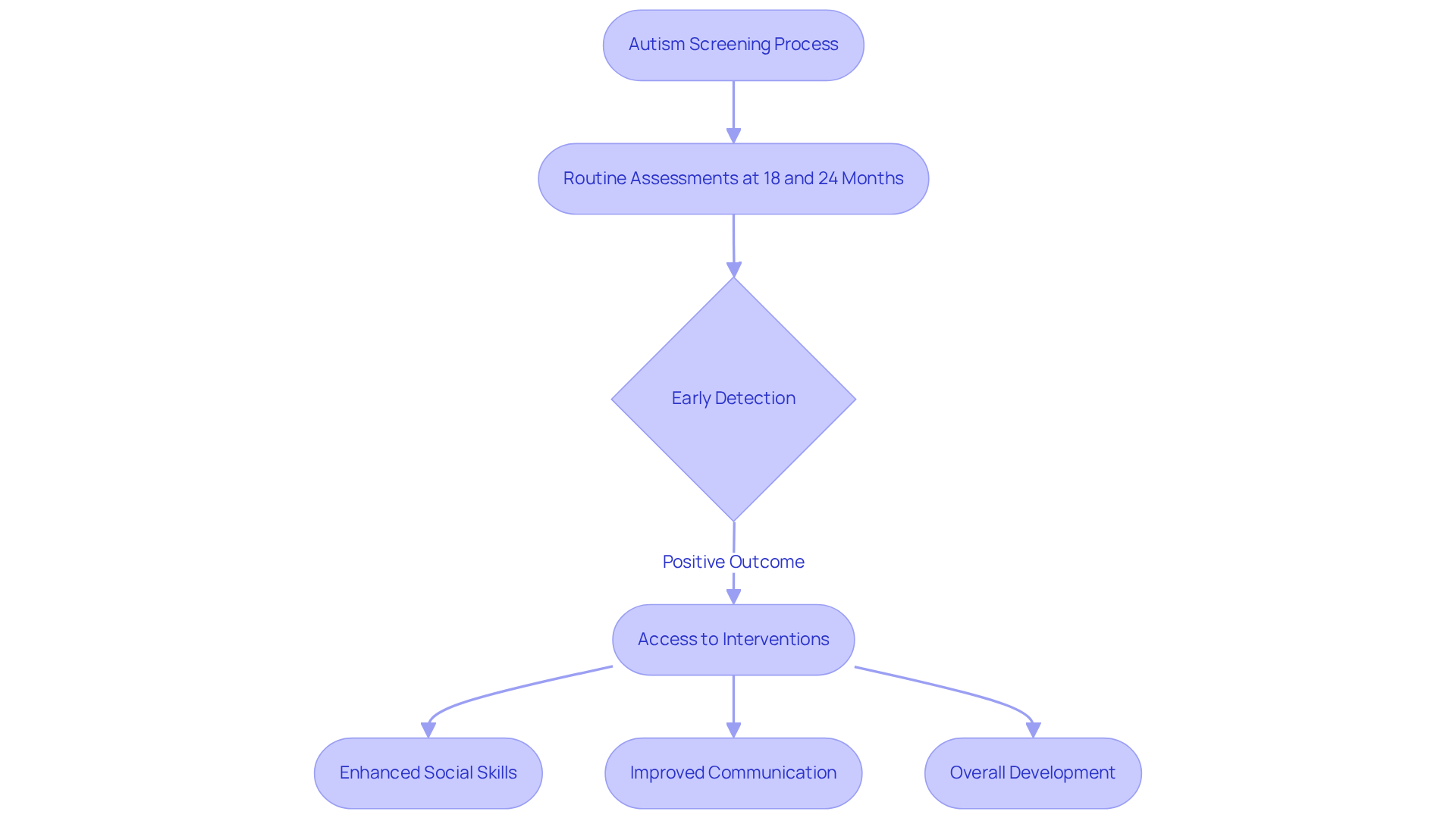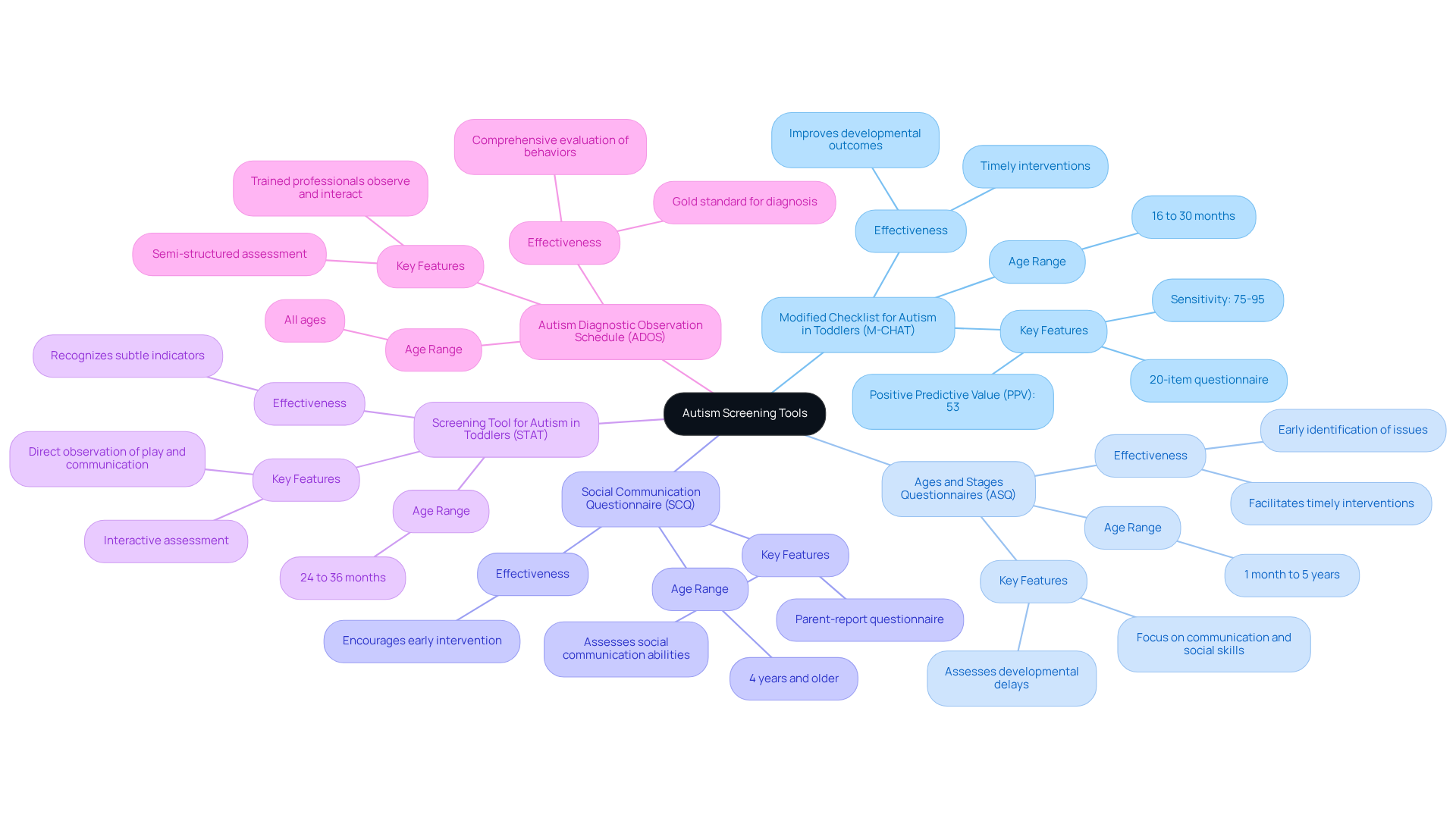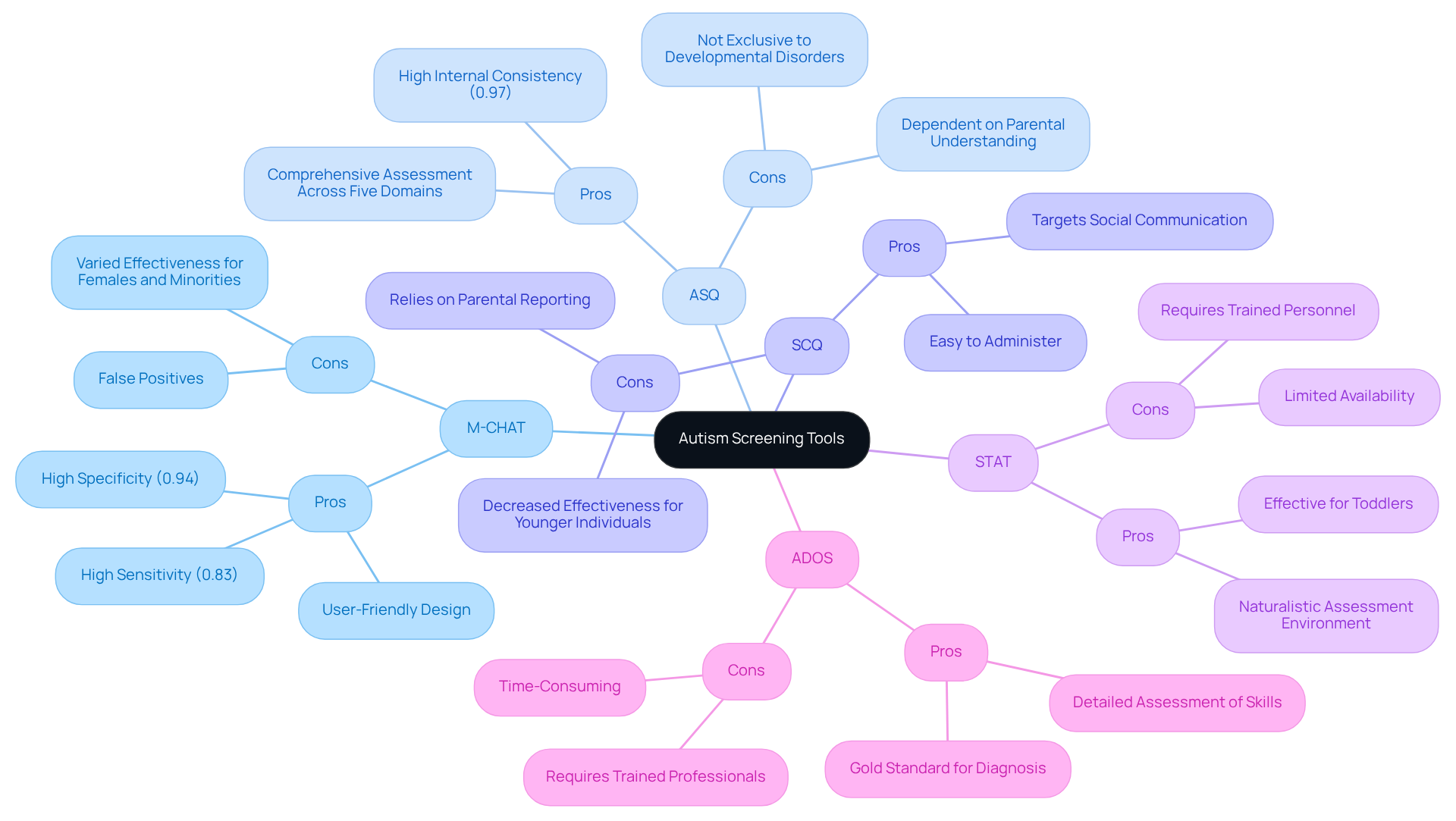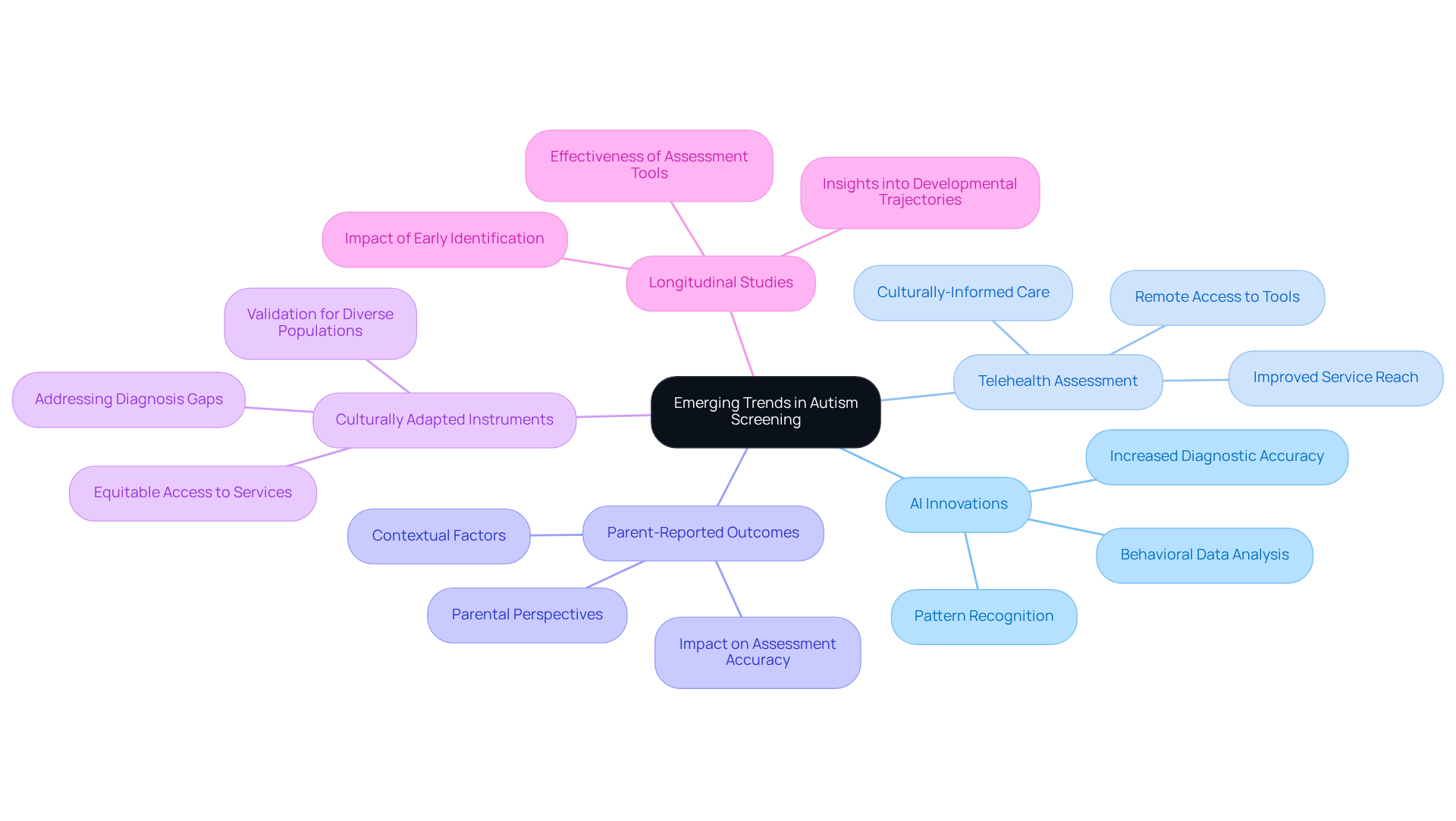Overview
In this article, we explore the essential screening tools available for testing autism, such as the Modified Checklist for Autism in Toddlers (M-CHAT), Ages and Stages Questionnaires (ASQ), and the Autism Diagnostic Observation Schedule (ADOS). These tools are not just assessments; they represent a vital step in understanding and supporting our children. Each tool is thoughtfully assessed, revealing both its strengths and weaknesses, and underscoring the crucial role of early detection and intervention in fostering positive developmental outcomes for children at risk for autism spectrum disorder.
As parents, we understand the weight of these concerns. The journey can be daunting, but knowing that there are effective tools available can bring a sense of hope. Early detection can make a significant difference, and by familiarizing ourselves with these resources, we empower ourselves to take action. Together, we can navigate this path with compassion and understanding, ensuring our children receive the support they need.
Introduction
Understanding the complexities of autism spectrum disorder (ASD) and the tools available for its screening is more critical than ever. As developmental disorders continue to rise in prevalence, many parents find themselves feeling overwhelmed and concerned. Early identification through effective screening can lead to timely interventions that dramatically improve a child’s developmental trajectory.
But with a myriad of screening tools available, each with its strengths and limitations, how can parents and caregivers determine the most effective method for their child's unique needs? This article delves into the various autism screening tools, evaluating their effectiveness and exploring the latest innovations shaping the future of developmental assessments.
We invite you to join us on this journey of understanding and support.
Understanding Autism Screening: Definition and Importance
Autism assessment is a crucial process designed to identify children who may have autism spectrum disorder (ASD) or are at risk for developmental delays. Early detection is vital, as it allows for timely interventions that can significantly improve outcomes for children. The American Academy of Pediatrics recommends that assessments occur during routine pediatric check-ups at 18 and 24 months. This proactive approach ensures early access to essential services, enabling families to receive the support they need to help their children thrive.
Effective evaluation not only leads to earlier diagnoses but also guarantees the implementation of appropriate interventions that enhance social skills, communication, and overall development. Recent research indicates that early intensive behavioral intervention can profoundly impact the development of young individuals with developmental disorders. This underscores the importance of evaluations in fostering positive growth trajectories for those on the spectrum.
As highlighted by the CDC, the prevalence of developmental disorders has risen to 1 in 36 children, which emphasizes the urgent need for effective evaluation methods. As Kyle Coddington, CEO of Prospera Healthcare, poignantly notes, 'With rates of developmental disorders increasing, understanding the latest statistics is more important than ever for families and advocates.' This is a call to action for all parents and caregivers: seek out assessments and support to ensure your child receives the best possible start in life.

Overview of Common Autism Screening Tools: Features and Applications
Understanding the probability of developmental disorders in youth is a journey that many parents embark on, and knowing which screening is used to test for autism can significantly impact the evaluation process. Each tool is tailored for specific age ranges and developmental needs, providing a roadmap for support and intervention.
- Modified Checklist for Autism in Toddlers (M-CHAT): This widely used 20-item questionnaire empowers parents to evaluate behaviors linked to developmental disorders in children aged 16 to 30 months. With a sensitivity rate between 75% and 95%, and a positive predictive value (PPV) of 53% in the elevated likelihood group, the M-CHAT is an example of which screening is used to test for autism. Research shows that using the M-CHAT effectively can lead to timely interventions, significantly improving developmental outcomes.
- Ages and Stages Questionnaires (ASQ): The ASQ is a valuable tool for assessing developmental delays across various areas, including communication and social skills, for children from 1 month to 5 years. Numerous studies support its effectiveness in detecting autism-related concerns, emphasizing which screening is used to test for autism in comprehensive developmental monitoring. For instance, the ASQ has been shown to identify developmental issues early, facilitating timely interventions that can change a child's trajectory.
- Social Communication Questionnaire (SCQ): This parent-report questionnaire is designed to assess social communication abilities in children aged 4 years and older. It serves as a valuable resource for recognizing potential signs of developmental disorders in older youth, encouraging early intervention to foster growth and development.
- Screening Tool for Autism in Toddlers (STAT): The STAT is an interactive assessment that involves direct observation of a child's play and communication skills, suitable for those aged 24 to 36 months. Its hands-on approach allows for a nuanced understanding of a child's social interactions and communication skills, which screening is used to test for autism, making it especially effective in recognizing subtle indicators of developmental concerns.
- Autism Diagnostic Observation Schedule (ADOS): This semi-structured assessment requires trained professionals to observe and interact with the child, providing a comprehensive evaluation of social and communication behaviors. The ADOS is considered a gold standard in diagnosing developmental disorders, which screening is used to test for autism, offering detailed insights into a child's developmental profile.
Each of these instruments possesses unique characteristics and applications, making them suitable for various settings and age groups. As our understanding of developmental assessments continues to grow, incorporating these resources into standard pediatric care is becoming increasingly essential for early identification and intervention. Together, we can create a supportive environment that fosters the best outcomes for our children.

Evaluating Effectiveness: Pros and Cons of Each Screening Tool
When considering the effectiveness of tools, it’s important to thoughtfully weigh their pros and cons, particularly regarding which screening is used to test for autism, especially as a parent navigating these decisions.
M-CHAT is a tool that many find effective. It boasts a pooled sensitivity of 0.83 (95% CI, 0.77-0.88) and a specificity of 0.94 (95% CI, 0.89-0.97), which makes it quite effective in detecting autism. Its user-friendly design allows for easy administration and scoring, which can be a relief for busy parents. However, it’s worth noting that which screening is used to test for autism may vary in effectiveness for females and minority children. Additionally, false positives can lead to unnecessary follow-up assessments, adding stress to the screening process.
Another option is the ASQ, which offers a comprehensive assessment across five developmental domains using 30 items, making it suitable for a wide age range. With a high internal consistency reliability of 0.97, this tool provides robust measurement properties. Yet, it does depend on parental understanding, which can vary, and it is not exclusive to developmental disorders, potentially leading to overlooked diagnoses.
The SCQ specifically targets social communication, which is a vital area for autism diagnosis and represents one of the screenings used to test for autism, and it is easy to administer, making it accessible for parents and caregivers. However, its effectiveness tends to decrease for younger individuals, and it relies heavily on parental reporting, which can introduce subjectivity into the results.
STAT engages children in play, creating a naturalistic assessment environment that is effective for identifying autism in toddlers. Yet, it does require trained personnel for administration, which may limit its availability in certain settings, potentially restricting access for families.
Lastly, the ADOS is often regarded as the gold standard for autism diagnosis. It provides a detailed assessment of social and communication skills, offering valuable insights into a child's developmental profile. However, it can be time-consuming and necessitates trained professionals, which may not be feasible for all families due to accessibility issues.
In summary, while each instrument has its advantages, they also come with constraints that should be carefully considered when selecting the appropriate evaluation method, including which screening is used to test for autism. Ultimately, the choice of evaluation instrument should be guided by the specific needs of the child and the context in which the assessment is conducted. Remember, you are not alone in this journey, and seeking support is a vital step towards understanding and advocacy.

Emerging Trends in Autism Screening: Innovations and Future Directions
Recent advancements in screening methods for developmental disorders, specifically focusing on which screening is used to test for autism, are aimed at improving both accuracy and accessibility, making this a crucial development for families. Key innovations include:
- Artificial Intelligence (AI): Imagine a world where AI-driven solutions help us examine behavioral data and forecast the risk of developmental disorders with greater precision. These tools can analyze extensive datasets to uncover patterns that might escape human observers, significantly enhancing diagnostic accuracy. The CDC reports that the occurrence of autism has risen to 1 in 36 youths in the US as of 2023, underscoring the urgent need for effective evaluation methods.
- Telehealth Assessment: The rise of telehealth services has opened doors for remote access to assessment tools, greatly improving service reach, especially in underserved areas. Andy Shih, Chief Science Officer at Autism Speaks, reminds us that "as diagnosis rates rise, our focus should be on bridging gaps in healthcare access and ensuring access to culturally-informed care across the lifespan."
- Parent-Reported Outcomes: New methodologies are now incorporating parent-reported outcomes and observations, which enrich assessment accuracy by considering contextual factors that influence a young person's behavior and development. This approach is vital, especially since research shows that 72.5% of mothers of children with autism experience depressive symptoms, highlighting the importance of parental perspectives in the evaluation process.
- Culturally Adapted Instruments: There is a growing emphasis on creating assessment resources that are culturally aware and validated for diverse populations. This initiative aims to address gaps in autism diagnosis rates, ensuring that every youth has equitable access to evaluation services. Alarmingly, research indicates that diagnosis rates have surged by 315% among Hispanic children, illustrating the urgent need for culturally adapted resources.
- Longitudinal Studies: Ongoing research is dedicated to assessing the long-term effectiveness of various assessment tools. These studies evaluate how early identification impacts developmental trajectories, offering valuable insights into the benefits of timely interventions. A recent study published in JAMA Network Open revealed a staggering 175% increase in diagnoses of the condition over the past decade, emphasizing the critical nature of early detection.
These trends signify a transformative shift towards more personalized and accessible methods, specifically focusing on which screening is used to test for autism, which hold the promise of significantly enhancing early detection and intervention outcomes. As we navigate these changes together, let us remain committed to supporting one another and advocating for the resources our families need.

Conclusion
Understanding autism screening is a vital journey for ensuring that children receive timely and effective interventions. It is essential to recognize the significance of early detection and the various screening tools available, each designed to cater to different age groups and developmental needs. By implementing these assessments, families can navigate the complexities of developmental disorders more effectively, ultimately fostering positive outcomes for their children.
Key arguments include the effectiveness of tools like the M-CHAT, ASQ, SCQ, STAT, and ADOS, each offering unique advantages and limitations. It’s important to carefully consider the selection of a screening method, as the effectiveness of each tool may vary based on context and individual circumstances. Additionally, staying informed about emerging trends, such as AI innovations and culturally adapted assessments, is crucial, as these promise to enhance the accessibility and accuracy of autism screening.
As the landscape of autism screening continues to evolve, parents, caregivers, and advocates must remain proactive in seeking assessments and support. By prioritizing early evaluation and embracing new methodologies, families can ensure that their children are equipped with the necessary resources for healthy development. Together, let us advocate for improved access to screening tools and foster a community that understands the critical role of early intervention in shaping brighter futures for children with autism.
Frequently Asked Questions
What is autism screening?
Autism screening is an assessment process designed to identify children who may have autism spectrum disorder (ASD) or are at risk for developmental delays.
Why is early detection of autism important?
Early detection is vital because it allows for timely interventions that can significantly improve outcomes for children.
When should autism assessments occur according to the American Academy of Pediatrics?
The American Academy of Pediatrics recommends that autism assessments occur during routine pediatric check-ups at 18 and 24 months.
What are the benefits of effective evaluation for autism?
Effective evaluation leads to earlier diagnoses and ensures the implementation of appropriate interventions that enhance social skills, communication, and overall development.
What impact does early intensive behavioral intervention have on children with developmental disorders?
Recent research indicates that early intensive behavioral intervention can profoundly impact the development of young individuals with developmental disorders.
What is the current prevalence of developmental disorders among children?
According to the CDC, the prevalence of developmental disorders has risen to 1 in 36 children.
What is the message for parents and caregivers regarding autism assessments?
Parents and caregivers are encouraged to seek out assessments and support to ensure their child receives the best possible start in life.




